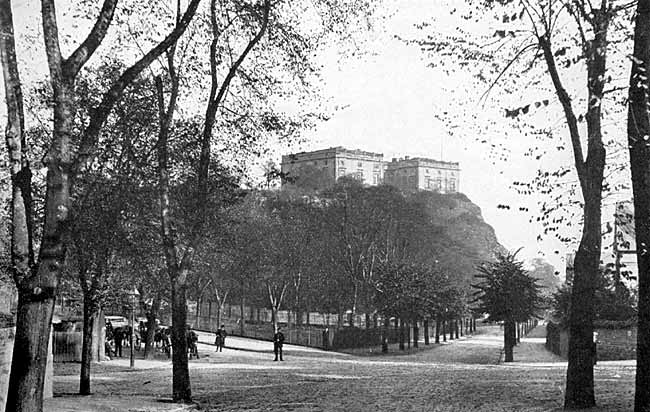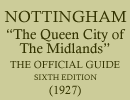NOTTINGHAM CASTLE.

Nottingham Castle.
The Castle Rock, rising on its south side to a height of 133 feet, must have been recognised at an early period as an ideal spot for a fortified post. William the Conqueror realised its importance, as we have already noted, and Henry I replaced his wooden structure by a building in stone. This was rebuilt and enlarged by Henry II, and it continued to grow in size and magnificence until during the reigns of Edward IV and Richard III it covered the whole of the ground now occupied by St. James' Church and the General Hospital.
This great mediaeval fortress was a residence of Norman and Plantagenet kings. It was John's headquarters in one of his attempts to usurp the authority of his brother Richard. When Queen Isabella, the mother of Edward III, was residing at the Castle, adherents of the king reached the keep by a subterranean passage still pointed out as Mortimer's Hole and seized her favourite, Roger Mortimer, Earl of March. It was from Nottingham Castle that Richard III marched to meet Henry Tudor at the battle of Bosworth Field and from which Henry VII set out to fight Lambert Simnel at East Stoke.
The Castle had become ruinous in the time of James I, and after the triumph of the Parliament in the Civil War Oliver Cromwell dismantled it. At the Restoration the Castle passed to the Duke of Buckingham, who sold it in 1674 to the Duke of Newcastle. He began the erection of a Renaissance mansion, completed in 1679, but this suffered partial demolition by fire in 1831, as a result of the popular fury against the then Duke of Newcastle for voting in favour of the rejection of the Reform Bill. In 1875 the Castle became the property of the Corporation, and after restoration work had been carried out it was converted into the Art Museum, opened in 1878 by King Edward VII and Queen Alexandra (then Prince and Princess of Wales). Portions of the ancient castle gateway, walls and outworks can still be seen.
The approach to the Castle from the Great Market Place via Friar Lane and Park Street, where there are some quaint old almshouses, has been greatly improved by the demolition of the old Riding School or Drill Hall, thus opening out to view the old Castle wall. Ornamental gardens have been laid out and a new entrance gateway to the Castle grounds has also been built. A fine view of the City and its surroundings can be gained from the terrace.
The Castle precincts are reached through the ancient gateway with its round flanking bastions. In the North Bastion Room are arranged British-Roman antiquities from the Roman Station of Margidunum on the Fosse Way. The ground rises gradually up to the Castle, and on the left is the memorial to Flight-Commander Albert Ball, V.C., while on the right is a memorial to the officers and men of the 59th Regiment who died in the Afghan War.
A band plays in the Castle grounds on Tuesday and Saturday evenings from May to the end of August, and during the same period there is a regular series of concerts by military bands, which are greatly appreciated both by residents and visitors.
THE ART MUSEUM.
On the ground floor of the Castle are courts containing collections of Decorative Art and Classical Antiquities, the latter being specially notable as including the collection of antiquities from the site of the Temple of Diana at Nemi, Italy, excavated and presented to the Museum by Lord Savile, G.C.B., F.S.A. The outstanding feature of the ceramics is the wonderfully fine collection of Wedgwood ware, while, the brown-glazed earthenware for which Nottingham is famous among collectors of pottery is well illustrated; other outstanding features are the Early English carriages, and the specimens of ornamental wrought iron work. In the section devoted to Oriental Art are some specimens of early Japanese arms and armour. Local items of much more than local antiquarian interest include the "Nottingham Hoard" of silver pennies, and Lucy Hutchinson's manuscript, "Life of Colonel John Hutchinson," and other documents relating to the Civil Wars.
A large gallery is devoted to Lace and Textiles, both hand and machine-made.
The Fine Art collections are hung in the galleries on the first floor, where different rooms are devoted to Early English and Flemish Paintings, Water-colour Drawings and Book Illustrations, Water-colours by some masters of the British School, Modern Paintings and Local Portraits and Views.
Catalogues, Illustrated Handbook and Guide may be obtained at the Museum, which is open from 10 a.m. until 8.30 p.m. during the summer months, and in winter Thursdays and Saturdays to 8 p.m. and other days 6 p.m. Open Sundays, 2 to 5 p.m., throughout the year.
Admission is free every day excepting Friday, when a charge of 6d. is made. The Director and Curator is Mr. G. Harry Wallis, F.S.A.
THE VICTORIA HALL.
This, one of the largest halls in the City, contains in addition to a large hall used for concerts, public meetings, etc., excellent lending and reference libraries. Lectures are given during the winter months, many of the most eminent men in the kingdom occupying the platform from time to time.
THE MECHANICS' INSTITUTION.
This building, opposite Victoria Station, was erected in 1844, damaged by fire some years later, and restored in 1867-8. The reading room was added in 1884.
THE GENERAL HOSPITAL.
An important recent addition to the public buildings of Nottingham, and one which can claim considerable distinction as a piece of modern architecture, houses the new Out-Patients' and X-Ray Departments of the Nottingham General Hospital. The Corporation presented the site of the new building to the Hospital authorities. Another storey has also been added to the Nurses' Home connected with the Hospital, thus giving an admirable finish to the building.
THE SCHOOL OF ART.
This building, in Waverley Street, is in the Italian style, and was erected in 1864. All branches of art, from freehand drawing to advanced oil painting, are studied here, and the high successes of the students place it among the finest art schools in the kingdom. An important study is textile designing, with special reference to the beautiful lace work manufactured in the City. The Headmaster is Mr. J. Else, R.B.S. A fine statue of the well-known Nottingham painter Bonington, has been erected in the grounds adjoining the building.
THE POST OFFICE.
This splendid edifice in Queen Street, built in 1898, is fully equipped to deal efficiently with the ever-growing postal and telegraph business of the City. It is open from 8 a.m. to 8 p.m.
